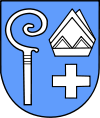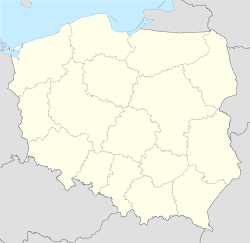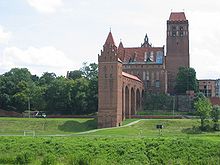- Kwidzyn
-
For other places called Marienwerder, see Marienwerder (disambiguation).
Kwidzyn Kwidzyn castle 
Flag
Coat of armsCoordinates: 53°44′9″N 18°55′51″E / 53.73583°N 18.93083°E Country  Poland
PolandVoivodeship Pomeranian County Kwidzyn County Gmina Kwidzyn (urban gmina) Established 11th century Town rights 1233 Government - Mayor Andrzej Krzysztof Krzysztofiak Area - Total 21.82 km2 (8.4 sq mi) Elevation 42 m (138 ft) Population (2006) - Total 37,814 - Density 1,733/km2 (4,488.4/sq mi) Time zone CET (UTC+1) - Summer (DST) CEST (UTC+2) Postal code 82-500 Area code(s) +48 55 Car plates GKW Website http://www.kwidzyn.pl Kwidzyn [ˈkfid͡zɨn] (German: Marienwerder, Prussian: Kwēdina) is a town in northern Poland on the Liwa river, with 40,008 inhabitants (2004). It has been a part of the Pomeranian Voivodeship since 1999, and was previously in the Elbląg Voivodeship (1975–1998). It is the capital of Kwidzyn County.
Contents
History
The Teutonic Knights founded an Ordensburg castle in 1232 and a town the following year. This new settlement of Marienwerder (German for "Mary's ait") became the seat of the Bishops of Pomesania within Prussia. The town was populated with Masurian settlers from the Duchy of Masovia. Werner von Orseln, who died in Marienburg (Malbork) in 1330, was buried in the cathedral of Marienwerder. St. Dorothea of Montau lived in Marienwerder from 1391 until her death in 1394; pilgrims would later come to pray in the town at her shrine. The rebellious Prussian Confederation was founded in Marienwerder on March 14, 1440.[citation needed] In 1466, the town became a Polish fief together with the remainder of the monastic state of the Teutonic Knights after their defeat in the Thirteen Years' War.
Marienwerder became part of the Duchy of Prussia, a fief of Poland, upon its creation in 1525. The duchy was inherited by the House of Hohenzollern in 1618 and was elevated to the Kingdom of Prussia in 1701. The town became the capital of the District of Marienwerder. After the First Partition of Poland, Marienwerder became an administrative seat of the new Prussian Province of West Prussia. The town and district were included within the government region of Marienwerder after the Napoleonic Wars.
According to statistics,[citation needed] in 1818 it was populated by a Polish speaking, Masurian majority. The policy of forceful[citation needed] Germanization, however, gradually decreased the share of Polish speaking inhabitants who participated in the social life of the province that spoke German. After 1871, when Marienwerder was included in the newly created German Empire, the Kulturkampf was aimed mainly at Catholics. In 1885 Marienwerder had 8,079 mostly Lutheran inhabitants, many of whose trades were connected with the manufacturing of sugar, vinegar, and machines. Other trades were brewing, dairy farming, and fruit-growing. According to official statistics, ca. 1910 35.7% of the county's population was Polish.
After World War I, the Treaty of Versailles of 1919 transferred most of West Prussia to the Polish Second Republic. The treaty permitted the East Prussian plebiscite in a few areas. To determine if Marienwerder would remain in Germany as part of East Prussia or join Poland; 93,73% of the inhabitants of the town voted on 11 July 1920 for East Prussia, to which the town was joined.
During the Weimar Republic, a Polish high school was founded in the town. On August 25, 1939, pupils of the school were deported to Nazi concentration camps[citation needed].
In 1945 during World War II, Marienwerder was plundered by the Soviet Red Army. Red Army established war hospital in the town for 20,000 people. The town's old center was burned by Soviet soldiers. The post-war Potsdam Conference placed it under Polish administration in 1945. Since then it remains as part of Poland. Burned parts of the town's old center were dismantled to provide material for the rebuilding of Warsaw after its destruction in the Warsaw Uprising.
The castle
Kwidzyn contains the partially-ruined 14th century Brick Gothic Ordensburg castle of the Teutonic Order, namely the Bishops of Pomesania within the Order. Connected to the castle to the east is a large cathedral (built 1343-1384) containing the tombs of the bishops as well those of three Grand Masters of the Teutonic Knights.
The literally outstanding feature of the castle is a sewer tower which is connected to it by a bridge. The tower used to be placed at the river which has changed its course since, leaving it on dry land.
Modern town
The town also has a Catholic church and a cathedral-castle presently used for the museum of Lower Powiśle.
Other sights include the appellate court for Kwidzyn County, a new town hall, and government buildings.
A branch of the company International Paper is located in Kwidzyn, as is the Kwidzyn School of Management. The second biggest employer is Jabil which is one of world leading EMS (Electronics manufacturing services) companies.[citation needed] The city has a lower than national average crime and unemployment rates when compared to the average rate in Poland average.[citation needed] Success in this field was gained through high level of sport programs for youths. Programs such as MMTS Kwidzyn (handball) or MTS Basket Kwidzyn are the best examples of this.[citation needed]
People
- Johannes Marienwerder (1343–1417), theologian
- Dorothea of Montau (1347–1394), saint
- Rudolf von Auerswald (1795–1866), Prime Minister of Prussia
- Hermann von Dechend (1814–1890), first President of the Reichsbank
- Ernst Kossak (1814–1880), journalist
- Rudolf Heidenhain (1834–1897), physiologist
- Gustav Cohn (1840–1919), economist
- Kurt Rosenfeld (1877–1943), politician
- Józef Krasnowolski (1879–1939), artist
- Thuro Balzer (1882–1967), painter
- Fritz Goerdeler (1886–1945), mayor in 1920-33
- Kurt-Jürgen Freiherr von Lützow (1892–1961), general
- Joachim Witthöft (1887 – 1966) general
- Rolf Lahr (1908–1985), diplomat
- Hardy Rodenstock (born 1941), music publisher and manager
- Wojciech Belon (1952–1985), poet, songwriter and folksinger
- Tomasz Piotr Nowak (born 1956), politician
- Jacek Borcuch (born 1970), actor and film director
- Marek Szulen (born 1975), composer of electronic music
- Maciej Silski (born 1976), singer
Burials
- Otto Friedrich von der Groeben (1657–1728)
- Werner von Orseln
International relations
Twin towns — sister cities
Kwidzyn is twinned with:
References
- This article incorporates information from the revision as of June 9, 2006 of the equivalent article on the German Wikipedia.
- Bibliography
- Stephen Turnbull: Crusader Castles of the Teutonic Knights: The Red-Brick Castles of Prussia 1230-1466, [1]
- Notes
- ^ "Stadt Celle". www.celle.de. http://www.celle.de/index.phtml?sNavID=342.65&La=2. Retrieved 2010-01-05.
External links
- Municipal website (Polish)
- Kwidzyn School of Management
- Kwidzyn City Portal (English)
Coordinates: 53°44′N 18°55′E / 53.733°N 18.917°E
Seat Kwidzyn (urban gmina)
Urban-rural gmina Rural gminas Seat (not part of the gmina) Kwidzyn
Villages Baldram · Brachlewo · Brokowo · Bronno · Bursztych · Bystrzec · Dankowo · Dubiel · Gilwa Mała · Gniewskie Pole · Górki · Grabówko · Gurcz · Janowo · Jurandowo · Kamionka · Korzeniewo · Kramrowo · Licze · Lipianki · Mały Baldram · Mareza · Nowa Wieś Kwidzyńska · Nowe Lignowy · Nowy Dwór · Obory · Ośno · Paczkowo · Pastwa · Pawlice · Piekarniak · Podzamcze · Pole Rakowieckie · Pólko Małe · Rakowice · Rakowiec · Rozpędziny · Stary Dwór · Szadowo · Szadowski Młyn · Szałwinek · Szopowo · Tychnowy · Wola-Sosenka
Categories:- Castles of the Teutonic Knights
- Cities and towns in Pomeranian Voivodeship
- Kwidzyn County
Wikimedia Foundation. 2010.




